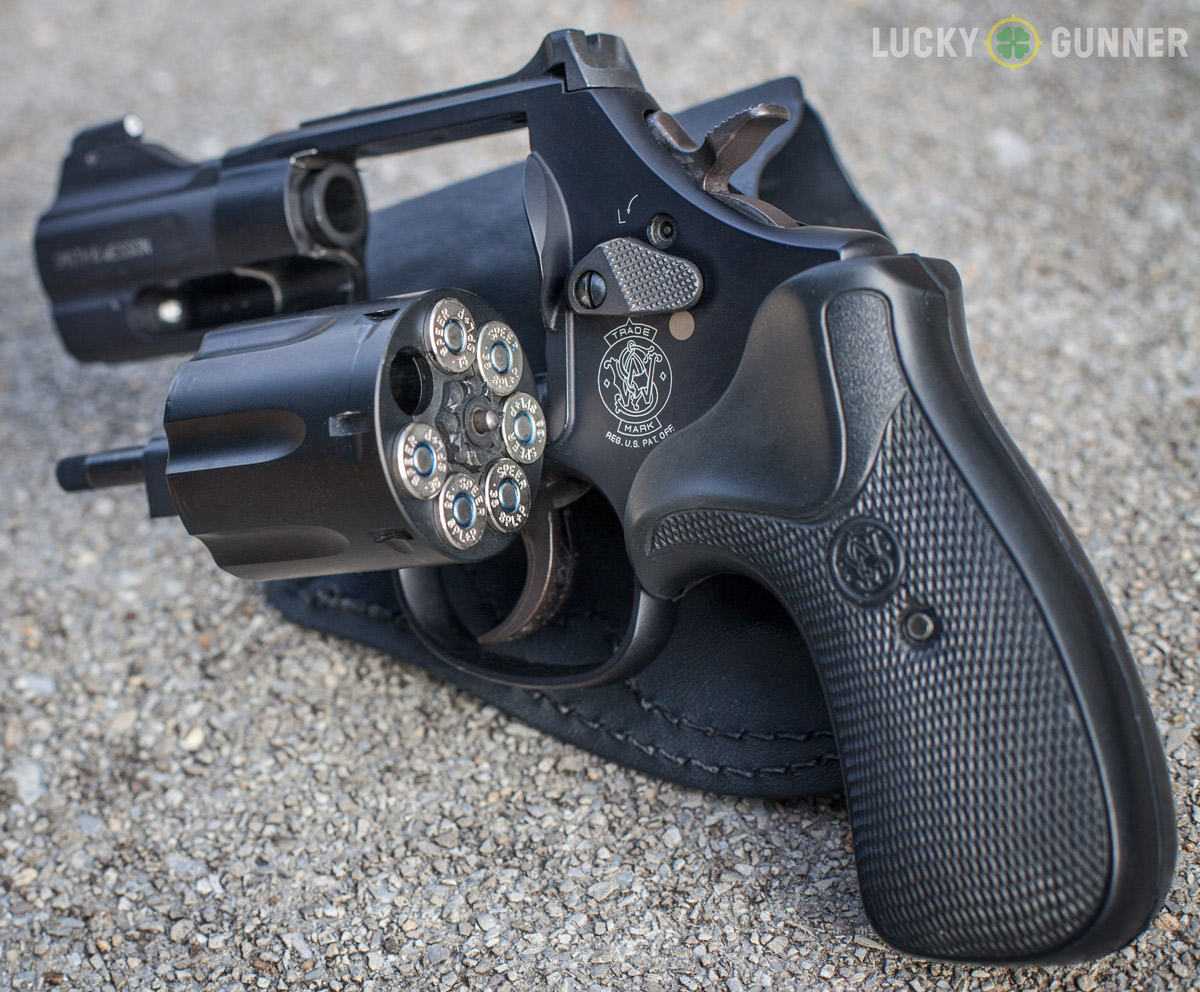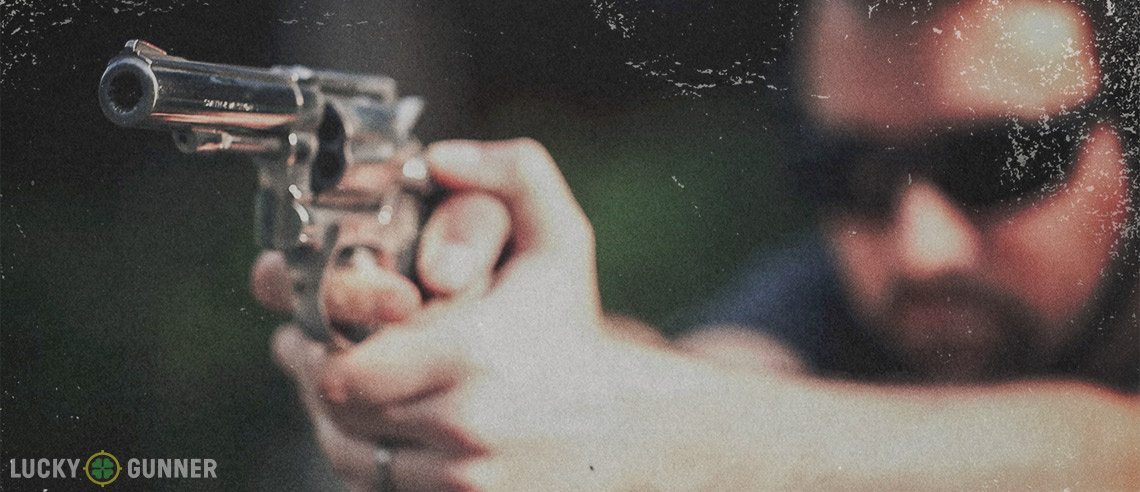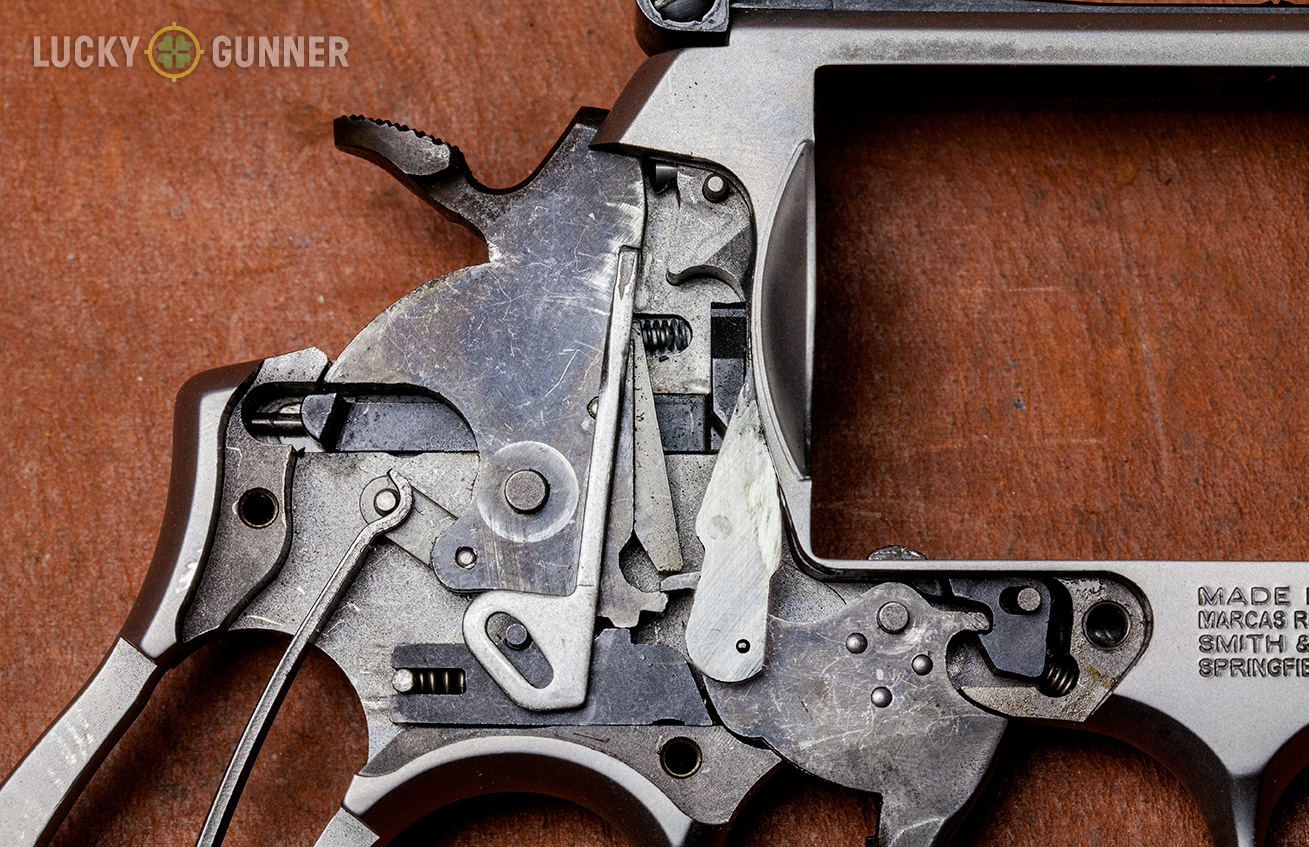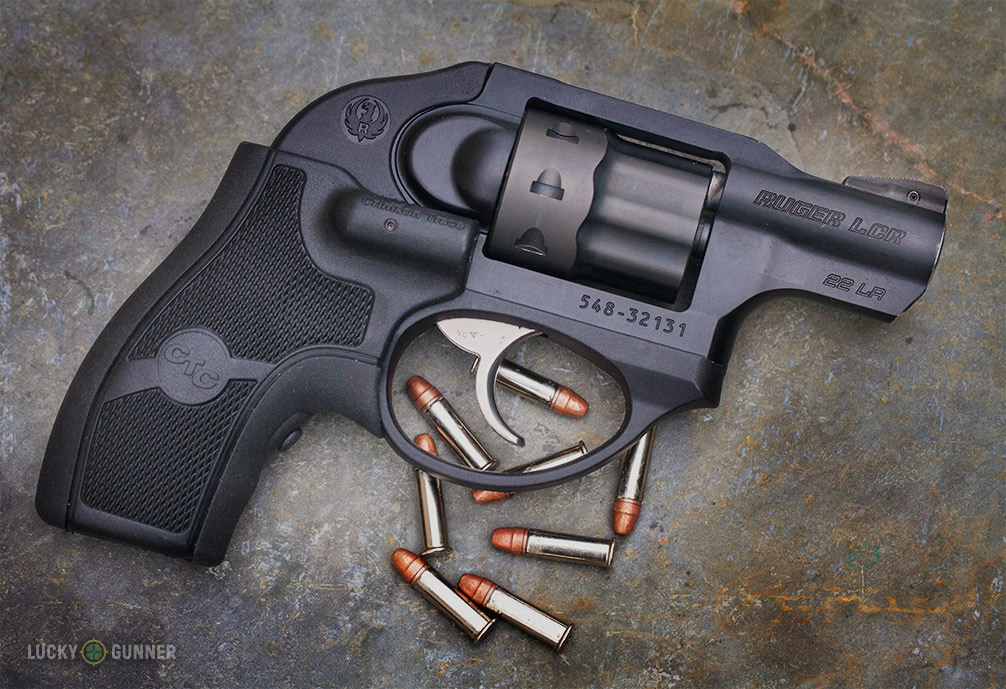Welcome to the third installment in our Wheel Gun Wednesday series. Every Wednesday, I’ll be exploring a topic related to revolvers as modern self-defense tools. This week, we’re taking a deeper look at some of the advantages often attributed to revolvers and whether the common wisdom is all its cracked up to be.
When I first launched this discussion about revolvers a few weeks ago, it quickly became obvious that you guys have a lot to say on the topic. This is one of those issues that can start bar fights among gun owners. I’m encouraged by the fact that so many readers seem to have given this some serious consideration and are willing to thoughtfully share their (sometimes extensive) perspectives in the comments section. That’s not to say we didn’t have to moderate some 8th grade-level name-calling mixed in there too, but overall you guys kept it classy, so thanks for that.
Before we get too much deeper into our Wheel Gun Wednesdays, I should clarify an important point. For the purpose of our discussions, I’m focusing almost exclusively on revolvers as self-defense tools against human threats. Revolvers used for hunting or wilderness protection are another matter entirely. We might get around to broadening that discussion at some point in the future, but for now you can assume we’re talking about revolvers used for everyday concealed carry, or for personal protection in the home or car.
So with that focus in mind, let’s take a look at a couple of the advantages that revolvers supposedly offer over semi-automatics. The transition from the revolver to the semi-auto as the favored handgun for personal protection in the U.S. has emphasized two major advantages that semi-autos can claim: they have much higher ammo capacity and they’re easier to shoot well. These are great things to have on your side if you end up in a fight for your life.
Those who advocate for the relevance of the revolver will often counter with one or both of following arguments: Revolvers are more reliable and more accurate than semi-autos. There are plenty of other advantages of wheel guns, but in my experience, these two seem to be the most commonly repeated. Are they still true and relevant today?
Are Revolvers More Accurate?
Let’s start with the accuracy claim because I find this one the most dubious. If we’re comparing modern production double action revolvers to modern production semi-auto pistols, there’s really no case to be made for revolvers being inherently more accurate. Others have done a great job of explaining some of the technical reasons behind this, but let’s suppose for a moment that some revolvers on the market do provide a slight edge in mechanical accuracy. For self-defense purposes, that only matters if the shooter can actually fire it more accurately. In double action. Under stress.
The vast majority of shooters, myself included, have not mastered the double action trigger to the degree that they can take full advantage of the revolver’s mechanical accuracy potential in any kind of shooting other than slow fire on a static range. And even if that weren’t the case, what kind of difference in accuracy are we talking about? It’s not at all uncommon for bone stock semi-auto pistols to be capable of two inch groups at 25 yards. Does a defensive handgun really need to be more accurate than that?
The mechanical accuracy issue is a complete red herring if we’re talking about self-defense. What’s far more important is the practical accuracy of that gun in your hands. If you personally shoot a revolver more accurately at speed than you do a semi-auto, then a revolver might be the better choice for you. Most shooters, however, will shoot a semi-auto more accurately and with less training than a double action revolver, despite whatever marginal difference may or may not exist in mechanical accuracy.
Are Revolvers More Reliable?
This one is tricky. Unlike the accuracy myth, it’s not that the claims of revolver reliability are flat out false, but I think they’re a bit overblown.
It’s often said that revolvers “don’t jam.” I guess that depends on what is meant by “jam.” They don’t have feeding issues the way semi-autos do, but revolvers do experience malfunctions that cause them to stop working.
Just to name a few: excessive fouling under the extractor star can lock up a cylinder. Recoil from lightweight revolvers can cause bullets to wiggle their way out of the shell casing which can also prevent the cylinder from rotating. The ejector rod can work itself loose and make it nigh impossible to open up the cylinder without breaking out the tool box. And of course there are the issues that come up during the reloading process like incomplete extraction and cases stuck under the extractor. Revolvers may not have feeding issues, but a quick tap-rack-bang is not enough to clear most of these other potential problems.
Fortunately, revolver malfunctions are fairly uncommon, especially when the gun is well maintained. But the same could be said for many (though far from all) of today’s semi-autos. For example, my full size Smith & Wesson M&P9 is coming up on 4000 rounds since I last had a stoppage of any kind. There’s a chance that a revolver could be even more reliable, but I’m more than okay with relying on a gun that’s had a 4000:1 record.
Reliability in Context
That’s not to say a revolver does not have some significant advantages related to reliability. They do, but they’re more situational. The most well known is the revolver’s ability to be fired multiple times from inside a coat pocket or purse. You can get at least one shot off with a semi-auto, but chances are good that the slide will hang up on the material inside the pocket.
Of course, that’s only relevant if you want to carry in a pocket or purse. Personally, I’m more attracted to the revolver’s lack of ammo sensitivity. With a .357 magnum wheel gun, I can be pretty confident that just about any cartridge I can cram into those chambers is going to work. And even if it doesn’t go bang, it won’t tie up the gun for any longer than it takes me to squeeze the trigger again.

This might be a useful attribute in some kind of Walking Dead post-apocalypse where I’m scrounging for ammo, but there’s a practical everyday application too. I go out of my way to make sure that the semi-autos I own have a reputation for reliability, but I still don’t trust a new one until I’ve got at least 500 trouble-free rounds through it. And then I like to fire another 100 rounds of my carry ammo just for good measure. Any time I experience a malfunction, I try to figure out what went wrong and then run another couple hundred rounds through it to make sure it’s fixed.
A revolver doesn’t need nearly as much range testing. I don’t have to worry about the magazine as a failure point, and unless I’ve fiddled with the internals to improve the trigger, I don’t have to give the reliability of the ammo much thought, either. I’ll run some of my carry ammo to check the point of aim and get a feel for the recoil impulse, but that’s about all that’s necessary. Far less time and money has to be devoted to troubleshooting and verifying the functional status of a revolver, allowing the shooter to focus on actual practice.
Then there’s the legend of the old dusty revolver neglected for decades in the drawer of the bedside table. Without magazine springs to wear out and the necessity for regular lubrication, a revolver that works today can be counted on to work again many years into the future.
As I already mentioned, revolvers do require maintenance. Shooting and carrying a revolver introduces wear and tear and foreign particles that can eventually cause problems. The same is true for a semi-auto, but the semi-auto also requires periodic maintenance even if it’s not being used. Sure, those magazines might keep feeding if the spring is compressed for a decade or two, but there’s certainly no guarantee (read our post Do Loaded Magazines Wear Out Magazine Springs? for more on that debate).
Ideally, everyone who owns a revolver for self-defense would be getting in plenty of regular practice and training, but of course that’s not reality. Fortunately, the neglected revolver will most likely still function, even if its owner is not particularly well practiced. And there may be other benefits to the revolver for this category of gun owner, but we’ll wait until next week to dive into that one.






The revolver is USUALLY more inherently reliable. However I have seen revolvers get out of time and lock up on a couple of occasions. The main advantage of semi-autos is the availability of more ammunition and a quicker reload. They are also flatter and are easier to carry concealed (depending on size of course). I carried a Mod. 19 Smith 357 as a Deputy Sheriff and felt very adequately armed. That said, today I would want one of the better semi-autos.
The model 19 is great. What ammo did you guys carry?
don’t remember the brand now but 158 grain hollow points – still have the gun and it is as beautiful now as ever – they don’t really do bluing like that much anymore
I have a Ruger 357 with 38 special rounds for the wife and a 44 mag for me. I also have several different semi autos too. I practice with all of them so I’m proficient in all of them. My wife, a reluctant shooter, prefers the wheel gun as it’s easier for her to operate. As she’ll carry it I’m ok with that. For her it is more accurate as its easier for her to use and reload. As for me I’m confident I can pick up any handgun and use it quickly if need be.
Not sure if troll or just the most ignorant comment ever made on this blog…
LG obviously your not as much as an expert as you think
K.
Great article. I do not own a double action wheel gun, but have been curious about them, especially as a carry weapon. I currently have a couple of M&P semi-autos, which I like very well, but I can now see some advantages to maybe adding a wheel gun to my arsenal.
Good article.
I have shot and carried revolvers, as duty and off-duty (and, now, retirement) guns since the 1970s. I think I have mastered the DA trigger fairly well, though you won’t see me on any youtubes.
I’ve heard a lot about unburned powder getting under the extractor star all my life, but in almost 40 years of shooting revolvers (and seeing lots of other people shoot them) I’ve never seen it. I have,though, seen a case rim get stuck under the star during a clumsy unload/reload.
I’ve also never seen a high primer hang up a cylinder, though I have seen ejector rods back out far enough to do that.
When I was an instructor in the 80s, I was told that it took 5 times as long to train an auto shooter to proficiency, because of the more complicated manual of arms. I didn’t believe it then and I don’t believe it now.
I have owned and carried revolvers by Colt, Smith, and Ruger. I still have several (but no Colts).
My carry gun is a 9mm auto. It is lighter, smaller, more concealable, carries twice the ammo, and is easier and faster to reload than any revolver. If it had the same trigger as my 70s-era K-frames, it would be perfect.
Nostalgia is good. So is progress.
I really enjoy these series of articles.
I have lost track of the goofy stuff I’ve seen happen to high round count wheelguns over the years, although my favorite is the gun that had one of the cartridges split in the chamber, so when the unsuspecting shooter went to do a speed reload, he ended up with a hole in his hand exactly the shape of the ejector rod.
Which, oddly enough, is where I have a scar to this day…
Ow.
All of the articles are great. I’m still in the learning stage and I keep all of the lg emails.
Although a nuby I do own two revolvers and two semiautomatics. My revolvers are simple compared to the semiautomatics, so since I got my CHL I’ve been practicing more with my Beretta and I carry a Glock 39. I still prefer the revolvers, but for real life situations, rare as that might be, the amount of ammo in the magazine does make a difference, although not much with a “baby” Glock. Also, I use a pocket holster and the semis are easier to conceal. Love my revolvers, and I do shoot more accurately with them, but who is going to be accurate in a dangerous situation?
You’re the second person today to mention owning a Glock 39. I thought those things were extinct. As far as real world accuracy, I’ll quote Ken Hackathorn: “Under conditions of stress you will rarely attempt any task you don’t have confidence in your ability to do.”
As a former police officer in the late 70’s and early 80’s, revolvers were all we could carry and was only .38 specials at that…we did carry the hottest loads we could find and were confident as we all shot very well, our range officer made sure of that and We were all competitive and like to bust bad guys and leave a mark when we did. They are accurate, always worked and if we needed more than 6 rounds, we had our riot guns and M-16s in the trunk if it was that bad…the good ole days . The 9mm are great weapons and I like the .45 but any of them will work just fine if your confident and know your way around your chosen weapon and will use it to put the bad guy down. Let the police do there job, keep the lawyers out of the mix and crime will go away real fast…did I mentioned the good ole days.
Good article. Practice is always the common denominator, look at Jerry Miculek with a revolver.. I started with revolvers in 1972 and didn’t get into semi-autos until about 1990 and have used them for USPSA competition. A well maintained firearm, revolver or pistol rarely fails in and of itself. Usually, it is an ammo issue for either firearm and for the semi auto improperly tuned/fitted magazines, fatigued magazine springs, improper recoil spring for the ammo and worn extractors. SO, if we want to debate the failure rates for both the semi-auto comes in second place because of the number of possible failure avenues. Like the previous writer, I too was a police officer and carried the big round thing. I am comfortable with either firearm, but out alone I carry a Taurus 380 and the operation and ballistics for the new 380 ammo is fine. Under stress at under 21 feet ( the crucial distant for a running assailant) either firearm will do. But if I am out with the Mrs. I prefer the revolver–call me sentimental. If we talk about civilian gunfights survival is best describe by “successful escape.”
Cops have a different job. .
Revolvers do not “jam” (jam being a failure to feed, fire, extract or eject) they can fail for your reasons listed above, but are extremely unlikely to do so. By comparison, under real world conditions, they are much more likely to fire tan an auto.
My Taurus M605 “jammed” right out of the box, brand new, on 2-3 chambers. Would not rotate the cylinder or allow pulling the hammer back to cock the hammer. if that’s not “jamming” I don’t know what is. I assumed it had to do with the poorly made ratchet not allowing the pawl to engage it properly preventing further completion of the action. Maybe. It worked better single action. Anyway, had to send it to Taurus in Miami at my expense following which that sent back a different gun with no explanation. That gun has worked OK so far but with little shooting. Anyone can see by the above photograph that they have a lot of small internal parts, some taking a lot of stress, that have to work together. They are like a cuckoo clock that goes bang. It would be great if someone would make a slo mo video with the gun open showing the parts operating close up in both single and double action operation.
That’s a great idea. We might have to try that…
Brownells used to sell a clear plastic sideplate for the S&W K-frame. It was meant for demonstrating the relationship between the internal parts, and not live fire.
Edited to add: The Vu-Plate is still available from Dayton Traister for $14.95.
Good article.
Is much pressure lost out the gap between the front of the cylinder and the barrel?